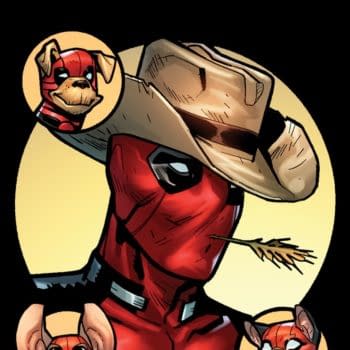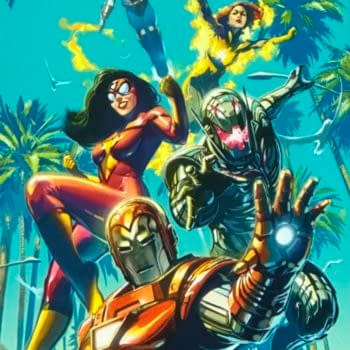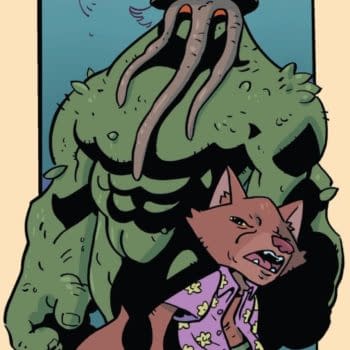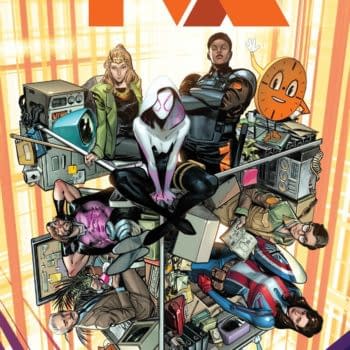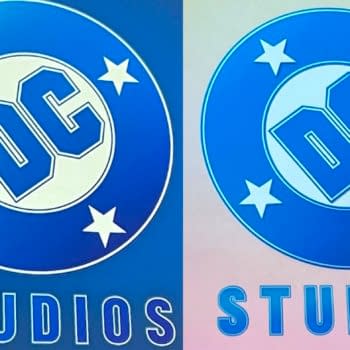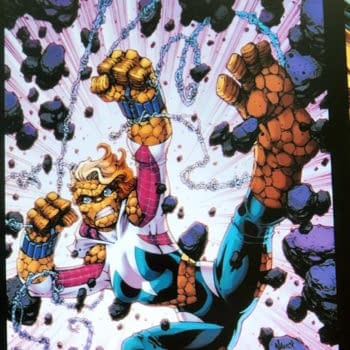Posted in: Comics, NYCC | Tagged: dark horse, Day Tripper, new york comic con, Two Brothers, umbrella academy
NYCC '15: Gabriel Ba And Fabio Moon Want Us To Make 'Different' Cool In Comics
Clearly the best panel of the day ran on Saturday morning at New York Comic Con, a Spotlight on Gabriel Ba and Fabio Moon, focusing on the value of being "different". We all know these two are cool. Their recent full graphic novel release Two Brothers from Dark Horse is an adaptation with very personal choices made from a major work of post-modern fiction in Brazil, and the graphic novel first appeared in Portuguese, but has now been translated by the brothers into English for the English-speaking world.

Some people feel that to "really work with Comics", you must work with superheroes and you've only "made it", if you work for Marvel or DC. They admitted that they used to think that "many years ago". Without intentionally devaluing the hard work of creators working in superhero comics, they only really came to understand the need for work outside of this field when they came to San Diego Comic Con in 1997. They were "aspiring comics artists" and "fans", who did what "all fans do", get in lines, watch panels and the like. Two years later, they had a booth for the first time. They finished off with a picture in front of their own Two Brothers banner to show their progress over time and the role of comic cons in their lives.

They encouraged the audience to walk the show floor and find the comics that are not in comic shops and not in the Diamond catalogue. They don't "cross the ocean", but "every once in a while" one of them will "stand out" from the "white noise" of all the superheroes and films. "Because they are different", they said.
Bone, Strangers in Paradise, and reality-based works caught their attention at their first SDCC. They may not seem "new and different" now, but everything then was different. One main story they liked was about a teenage girl on Mars. It was Paul Pope's THB. Pope was the product of "mixed" European and manga influence, which they feel gave Pope a chance to be very "different". Currently, Battling Boy, still reflects that. They recommended Brazilian artist David Rubin, on The Hero, currently published by Dark Horse.

"We're living in a great time in comics…everywhere", they said, with markets opening up between countries and topics. They believe "comics can be a lot more than what you're used to seeing" and this keeps "driving them" onward.
They've been traveling in the world of comics for 18 years and seeing different aspects of comic production everywhere, so they look to see what's being done, and "especially what's not being done" as well as looking at themselves to learn what they can do. Even if there was no comics market, they'd "never stop telling stories" they said. Going to SDCC each year and discovering new creators and "new possibilities" had a profound impact on turning them on to the "different" and the "cool".
During Q and A, I asked about whether they started off creating longer or shorter works and whether seeing the indie books at comic cons made them work mor ein the short form. They said they started with longer, big sagas in the beginning, which they never finished. What they needed to realize at the time was that short story anthologies are easier to get done, but not easier to do well, since short stories can be harder in a way to have an "impact". But it gives you something to "show" your work. Their original fanzine was 4 pages once a week. Short work also helps reach people who are not in the "habit" of reading comics. It was a great way to get "instant feedback" and learn how to "connect" with readers. Having to sell the zines by hand and make "pitches" to people buying them was good training. They never gave the zines away for free, because that would mean people wouldn't appreciate it. They left it to others to make a "little effort". Until 1997, they did lots of short stories, then from their SDCC experience, they wanted to do a "bigger comic" and felt they couldn't "hold it in anymore". Then they continued the fanzine, but made the narrative part of "one big story" over time. The fanzine helped them reach people who had never read comics before, and also see and gage reactions to their work in an invaluable way.
Asked what other artists have inspired them over time, they said there is a huge variety of stories being told in other mediums, like film, whereas comics seem to follow only certain genres and trends. So they were very influenced by books and films as well. Reality-based comics were a little bit depressing to them and they weren't inclined to go that way. It just wasn't really what they were inclined to do, so they looked still further for other types of comics to create. As teenagers, they loved poetry and music, and the way those mediums were able to suggest and convey, and there's "so much work to do in comics just to tell the same story" as those mediums can tell. They hope to achieve some of those effects, but in comics. They read everything, widely, from Sergio Aragones to Garfield, and superheroes. They make "daily life look like it has superpowers", based on all the comics they read growing up. And also "everybody is sexy" because that's the only way comics portrayed people, whatever body type or ethnicity. They feel that "every type of story taught us something".

When they did some BPRD stories, and also Casanova, they chose those projects because it gave them a sense there was an opportunity to do something different with the medium than had been done before, and that's why they were able to collaborate with others instead of just writing their own stories as well as draw them. Umbrella Academy even felt to them like a story that was really about family relationships. It has this "idea of how things are not going to end well" for several characters who are very different from one another, which causes conflict. Every time a new Umbrella Academy story comes up, there's a massive amount of character-designing, one of the most "challenging things we've ever done", they said. Which is why they did it and are doing it again.
Asked how the twins have influenced each other, the idea that there should be a "personal style" didn't occur to them for a long time, since they wanted to tell stories together. It's very "difficult to try something different", they said, including in your reading habits, but even as creators, it's hard to "try something new and risk it". It takes "courage". They wanted to tell stories that weren't "everywhere else" and when they "started", not everyone liked the comics because of that "difference". But they took a chance, and tried to reach new readers, partly through going with publishers who could help reach readers, too, like Vertigo for Day Tripper. People need a "push" sometimes to try something new, like a recognizable brand. Their new book, Two Brothers, is in black and white, which is quite different. People love colored books, but the twins feel that there is a "poetic force" in using black and white that was needed on the project, and it took courage to do it.










